#Mahango Game Park
Explore tagged Tumblr posts
Text
Namibia, Botswana, Simbabwe 2024/25 - Tag 22
Herrschaften und Oukies!!!
Wir haben unseren Aufenthalt in der Divava Lodge so geplant, dass uns genug Zeit für Aktivitäten bleiben.
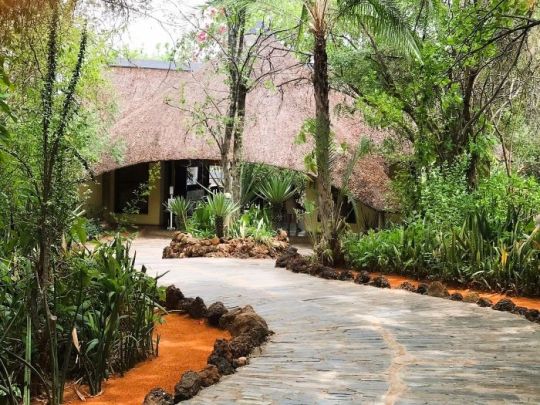
Doch bevor es los ging widmeten wir uns heute erst ausgiebig dem Frühstück. Dazu warteten wir erst einmal ab, bis alle anderen Gäste versorgt waren und in den Booten oder Pirschwagen hockten.
Die Lodge ist nämlich ziemlich ausgebucht und alle hatten irgendwelche Touren auf oder an dem Okavango gebucht: Angeln, Tiere gucken und was nicht noch.

Kurz nach 8 enterten wir dann die Holzplattform, die in den Okavango rein ragt, auf der die Terrasse des Restaurants eingerichtet ist.
Und bis wir unsere Klamotten zusammen gesucht haben, dauert auch immer so seine Zeit. Irgendwas sucht man ja ständig - und man findet es grundsätzlich dann wieder, wenn man es nicht mehr braucht!

Bis zum Mahango Game Reserve sind es von der Lodge nur ein paar Kilometer. Wir können also ganz entspannt einen privaten Gamedrive durch den Mahango Park unternehmen.
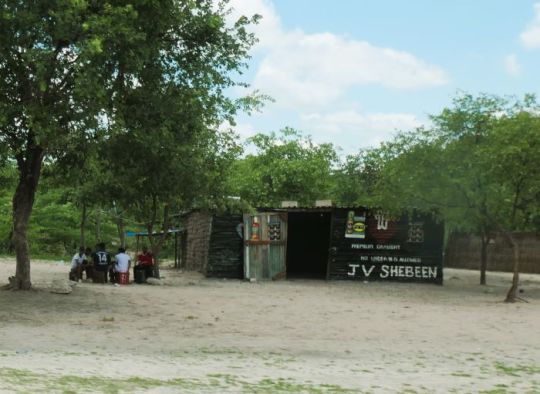
Allerdings hat die Besiedlung hier, in den letzten Jahren, doch erheblich zugenommen. Traditionelle Behausungen an den Pisten oder Nutzvieh auf den Pisten.
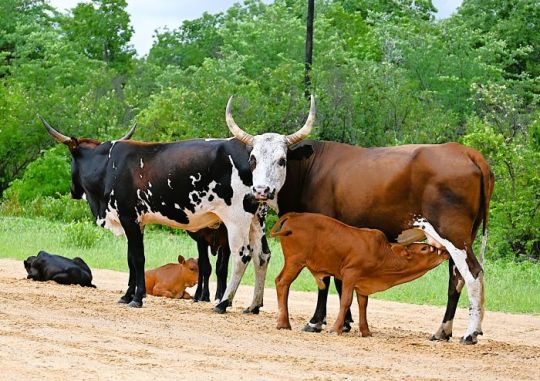
Mit rund 24.000 Hektar zählt der Mahango zu den kleinsten Nationalparks in Namibia. Der Park endet im Süden an der Grenze zu Botswana.
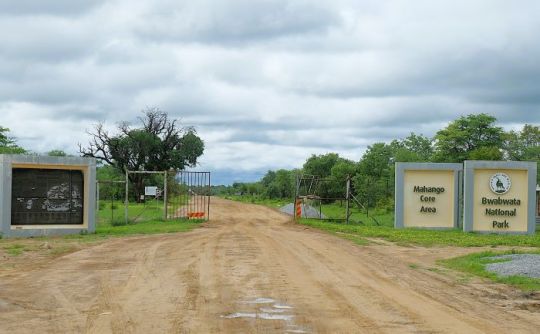
Und ob man es glaubt oder nicht, diese Wellblechpiste, auf der man geschüttelt und nicht gerührt wird, ist die offizielle Transitstrecke zum Grenzübergang Mohembo, nach Botswana.
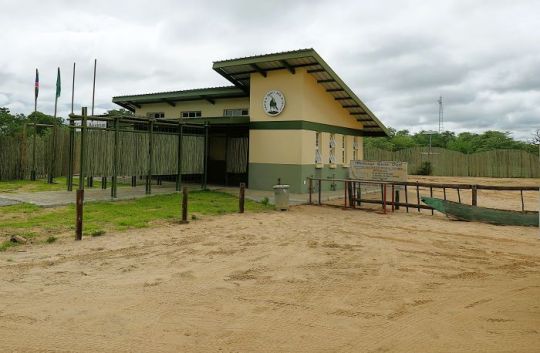
Am Eingang zum Nationalpark gibt es inzwischen ein funkelnagelneues Visitorcenter. Vorbei die Tage des 2011 mit deutschen Fördergeldern errichteten hölzernen Office:

Das Prozedere zum Befahren des Parks ist aber immer noch das Gleiche, dafür haben sich die Eintrittspreise drastisch erhöht. Insgesamt werden wir für 3 Personen plus Auto 400 NAD (etwa 20 Euro) los. Der Hasenbär wird einfach eingeschmuggelt.
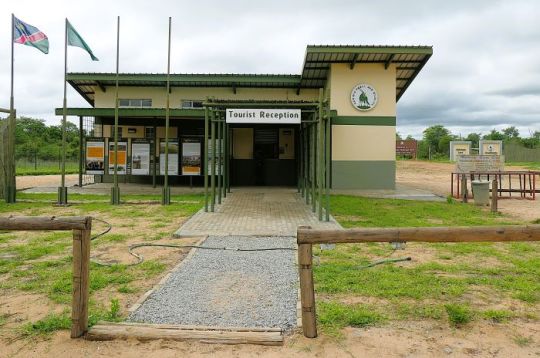
Dazu wird einem noch in dem funkelnagelneuen Office eine "aussagekräftige" Karte ausgehändigt, in der die Bemerkungen zum Zustand der Befahrbarkeit, von der Lady on Duty, händisch eingemalt werden:
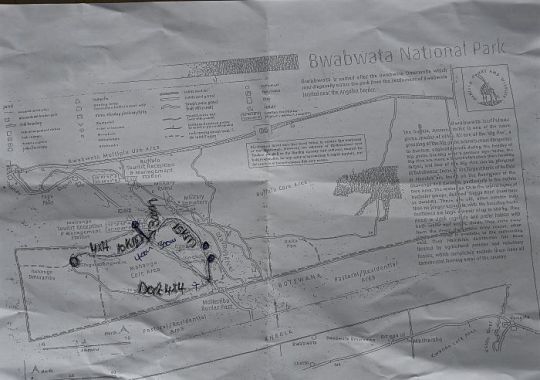
Jetzt wissen wir ja top Bescheid! Und es kann los gehen ...
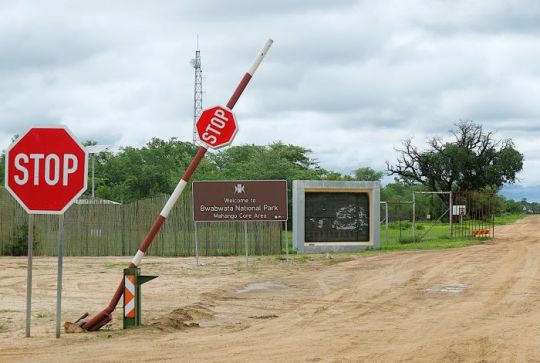
Der Nationalpark beherbergt eine große Artenvielfalt an Tieren, darunter auch vier der bekannten „Großen Fünf“: Elefant, Büffel, Löwe und Leopard.
Um es vorweg zu nehmen: dieses Mal haben wir davon nichts, aber auch gar nicht gesehen. Lediglich die omnipräsenten "Elefantenknödel", sowie die Spuren der Verwüstung an den Bäumen, zeigt uns die Anwesenheit der Elefanten an.
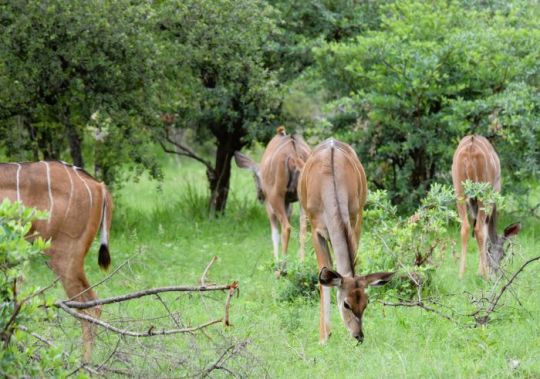
Dazu gehören auch die beiden berühmten "Giant Baobabs", hunderte von Jahren alt, inzwischen von den Elefanten niedergemetzelt. Von dem Ersten, der so um 2013 fiel, war überhaupt nichts mehr zu sehen.
Von dem Zweiten, der 2021 sein Leben ließ, war nur noch eine geringe Menge Kleinholz übrig. Die übrigen Reste hatten die Elefanten verspeist.
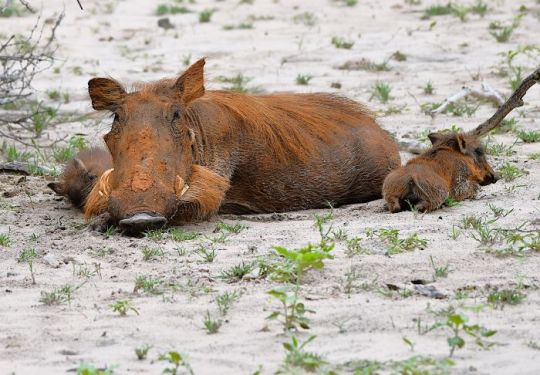
An den Ufern können Flusspferde und Krokodile sowie eine große Vielfalt an Wasservögel beobachtet werden. Über 400 verschiedene Vogelarten sollen gezählt worden sein, aber auch Rappenantilopen, Impala, Letschwe-Moorantilopen.
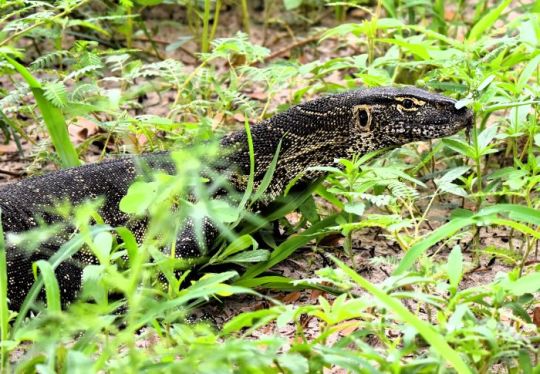
Für Krokodile ist es anscheinend eindeutig zu kalt, mit Temperaturen von etwas über 20 Grad bis maximal 25 Grad. Die zeigen sich nicht, dafür sind bei diesem Wetter die Warane bemerkenswert aktiv. Noch nie konnten wir so viele Nilwarane beobachten.

Bild oben: junge Nimmersatt-Störche, die das Wetter nur so mittel finden.
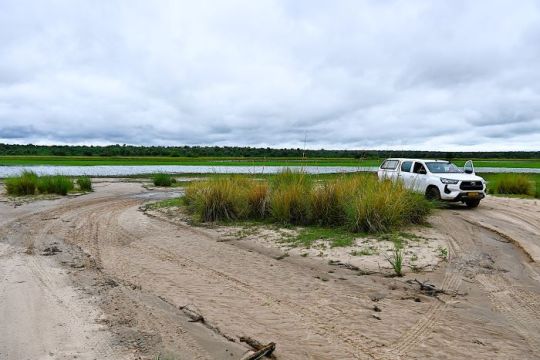
Besucher können entlang zweier Routen den Mahango Park erkunden. Wobei sicherlich die rund 40 Kilometer lange „Fluss -Schleife“ die lohnendere Route für Wildbeobachtungen ist.

Das einzige Großtier, das wir entdeckten, war ein totes Giraffenbaby. Ob es eine Fehlgeburt war oder ob es einem Schlangenbiss erlegen war, konnte wir nicht ausmachen. Jedenfalls war es kein Kill und auch noch nicht lange tot.
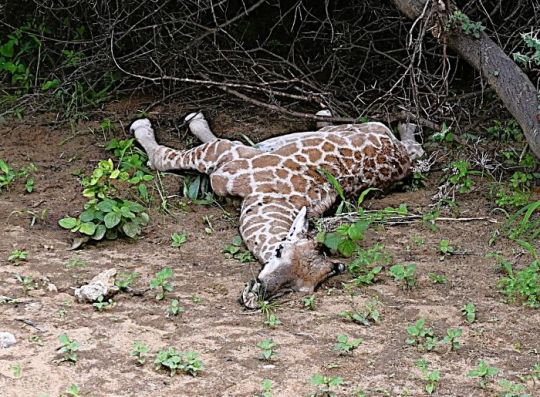
In der Zwischenzeit wurde es vom am Himmel immer dunkler, aber bis auf vereinzelte Tropfen hielt sich das Wetter und so fuhren wir die Flood Plains ab.

Die 3 von der Tankstelle: Nimmersatt (Storch), Glockenreiher (schwarz) und Großer Reiher (weiß).
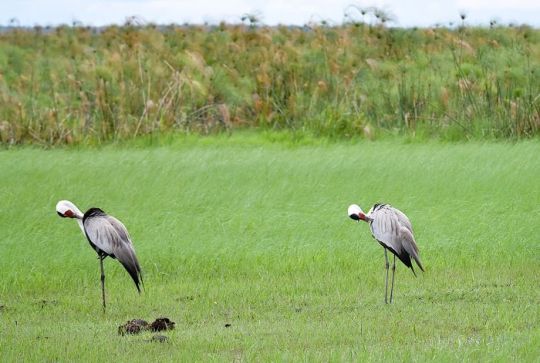
Das Ehepaar Klunkerkranich beim Synchronputzen des Gefieders. Man will ja schließlich ordentlich aussehen, so als Kranich.

Ein Blaustirnblatthühnchen (African jacana oder auch Lilytrotter) stochert im Ufersand herum. Warum müssen deutsche Begriffe eigentlich immer so kompliziert sein?

Ein Trauerdrongo. Der Stimmvirtuose unter den Vögeln, kann nicht nur Tierstimmen perfekt imitieren, sondern auch Handyklingeltöne, Radios, Toilettenspülungen usw. Immer gut zu erkennen an dem gegabelten Schwanz und den roten Augen.

Als dieser Pied Kingfisher vor uns wegfliegt, sieht es schon bedrohlich dunkel am Himmel aus. Und zack-bumm blitzte & krachte es um uns herum, der Himmel war pottschwarz und man sah kaum noch die Hand vor Augen. Durch das Getöse wurde auch noch eine Herde Impalas aufgescheucht. Das Wasser stand regelrecht um uns drum herum.

Als wir wieder in Richtung Lodge schlichen (von fahren konnte erstmal keine Rede sein), wurde das Unwetter immer weniger. Am Rand der Piste entdeckten wir nicht nur die üblichen Feuerholzverkaufsstände, sondern auch Holzschnitzer.

An einem dieser Stände kauften wir 2 jungen Burschen 3 Miniatur Mokoros (Einbaumboote) ab. Diese Mini-Boote werden in unserer Lodge als Seifenhalter genutzt. Eine nette Idee!
Als wir wieder an unseren Chalets waren, konnten wir es kaum glauben: hier hatte es gerade mal ein wenig getröpfelt!

Potenziellen Besuchern wird empfohlen, sich vorher über die jeweilige Befahrbarkeit der Routen zu informieren.
Wegen der teilweisen Abgeschiedenheit dieses Naturschutzgebietes ist äußerste Vorsicht ist geboten, wenn durch Bäche und Gräben gefahren wird, und während der Regenzeit kann der tiefe Matsch selbst für versierte Geländefahrer zu einer gewaltigen Herausforderung werden.
Der Mahango Game Park ist ausschließlich für Tagesbesucher von Sonnenaufgang bis Sonnenuntergang geöffnet.
Der Eintritt gilt für den ganzen Tag. Man kann so oft in den Nationalpark reinfahren, wie man möchte.

Zurück in der Divava Lodge geht es erst einmal in die Dusche. Wegen des Wetters fällt die Nutzung unserer schönen Außendusche leider buchstäblich ins Wasser und wir duschen drinnen.

Danach geht es für uns zum Abendessen, das, wegen des regnerischen Wetters, unter Dach stattfindet. Hektisch werden vom Personal die Möbel herein getragen und neu arrangiert.

Irgendwie müssen ja nun alle Gäste drinnen beköstigt werden. Nutzt ja alles nix. Regenschirme stehen ebenfalls für die Gäste an der Bar bereit.

Zum Glück liegen unsere Häuschen ziemlich nah an der Rezeption, so können wir in einer Regenpause schnell zurück flitzen. Andere, entfernter wohnende Gäste, lassen sich auch mit dem Elektrokarren fahren.
Lekker Slaap!
Angie, Micha, Mama & der Hasenbär
5 notes
·
View notes
Photo

Here we see a packy from Mahango Game Park in Namibia, as it munches on some delicious looking grass.
Photo found here.
7 notes
·
View notes
Text
Tra l’Angola e il Botswana, una sottilissima striscia di terra appartenente alla Namibia si allunga fino a raggiungere il punto in cui il fiume Kwando, che segna il confine con il Botswana, si getta nello Zambezi, che la separa dall’Angola, a pochi chilometri dal confine con lo Zimbabwe. Una lingua di territorio lunga 450 chilometri e spessa solo 30, insanguinata per tutta la seconda metà degli anni Novanta dallo scontro tra il governo namibiano e i separatisti della Caprivi Liberation Army. Dopo anni di atrocità, distruzione delle sue ricchezze naturali e bracconaggio, gli animali stanno tornando a popolare i parchi del Caprivi, insieme a qualche turista. Noi l’abbiamo percorsa da est a ovest, attraversando i parchi naturali ancora poco frequentati dagli stranieri e tagliati dalla statale B8, che collega Katima Mulilo a Rundu.
Un viaggio in autobus durato un’intera giornata ci ha portati da Victoria Falls a Katima, attraverso la regione settentrionale del Botswana. Più di otto ore, tra controlli sanitari, disinfezione delle suole delle scarpe e acquisizione di impronte digitali a ogni confine.
Katima Mulilo è la prima città che si incontra entrando in Namibia dal Botswana settentrionale: un avamposto di circa 30.000 abitanti, la città più lontana dalla capitale Windhoek. Qui è dove abbiamo ritirato la nostra auto a noleggio, una piccola Toyota Etios che ci ha accompagnati fino a Cape Town. Lungo la strada principale di Katima, si possono acquistare generi di prima necessità e il carburante necessario per proseguire fino a Rundu. Dopo le 18, gli unici luoghi per mangiare qualcosa sono i negozi dei distributori di benzina o i fast food annessi. Impossibile però pagare in dollari o con carta di credito straniera: essendo riusciti a cambiare circa 5 dollari in moneta locale grazie alla gentilezza della gerente della guest-house dove abbiamo alloggiato, siamo riusciti ad acquistare da bere e qualche snack per dormire a pancia piena.
Riposati e rifocillati, la mattina del nostro primo giorno in Namibia siamo partiti in direzione ovest. Nel giro di pochi chilometri, ci stiamo ritrovati da soli lungo la statale B8, un parco nazionale dietro l’altro, tra elefanti che ci hanno attraversato la strada e villaggi di capanne apparentemente disabitati.
Le nuvole di sabbia sollevate dai branchi di pachidermi, la boscaglia secca ai lati della strada e i rari alberi verdi, sinonimo di acqua nel sottosuolo, sono uno spettacolo che rivedo davanti a me chiudendo gli occhi. Seguiamo la C49 e poi la B8, attraversando il Wuparo Conservancy ed entrando nel Mudumu National Park, una delle aree più ricche di fauna fino agli anni Ottanta, quando divenne una concessione di caccia non ufficiale e gli animali furono decimati.
All’interno del parco di può visitare il bellissimo villaggio-museo di Lizauli, fondato a poca distanza dall’abitato per far conoscere ai viaggiatori gli stili di vita tradizionali del Caprivi. Le guide locali forniscono informazioni sull’alimentazione, i metodi di pesca, caccia e allevamento, l’organizzazione sociale e politica dei villaggi, l’artigianato, la medicina tradizionale, i giochi e la musica. E’ stata l’occasione perfetta per toccare con mano le usanze di una delle tante tribù namibiane, dagli stili di vita estremamente diversi l’una dall’altra.
I Kaprivian sono circa 80.000, divisi in cinque tribù: i Lozi, i Mafwe, i Subia, gli Yei e i Mbukushu. Agricoltura di sussistenza, pesca e allevamento di bestiame ne garantiscono la sopravvivenza. La lingua franca di questi popoli è un idioma derivato dal lozi, tribù che controllava tutta l’area fino al XIX secolo. Grazie proprio alla visita guidata al museo abbiamo scoperto che per allontanare gli animali feroci utilizzano una frusta che, picchiata a terra, produce un suono simile ad uno sparo. Una sorta di slitta in legno trainata da buoi è usata per i trasporti, mentre per proteggere il cibo conservato in ampie ceste costruiscono trappole per topi con la terra dei termitai e per difendere i polli dai predatori, durante la notte, li chiudono in piccole gabbie rialzate. La calabash, in italiano “zucca a fiasco”, è il recipiente usato per il trasporto dell’acqua e per la conservazione del latte, che al suo interno è fatto diventare acido, per poi impiegarlo nella preparazione del porridge. La musica dello xilofono è tipica delle grandi festività, quando tutto il villaggio partecipa alle celebrazioni e si cucinano cibi in grande quantità. Si mescola ai canti e al suono prodotto dalle gonne fatte in legno delle danzatrici.
Parte del progetto del museo è anche la vendita di prodotti artigianali, i cui proventi contribuiscono al sostentamento della comunità e alla tutela della fauna contro il bracconaggio, una piaga che ha afflitto (e ancora oggi continua) tutti i parchi della regione.
E’ solo dopo il cessate il fuoco del 2002 che il Bwabwata è stato dichiarato parco nazionale e i bracconieri non hanno più potuto sfruttare liberamente le risorse di quest’area. La Mahango Game Reserve, una riserva naturale che occupa solo 25 chilometri quadrati di superficie, è un paradiso per gli amanti della savana e degli animali. Senza la necessità di disporre di un fuoristrada, la si può visitare con calma in mezza giornata: il Circular Drive Loop è lungo 20 chilometri e permette di osservare facilmente la ricchissima fauna selvatica.
This slideshow requires JavaScript.
Nei pressi di Bagani il fiume Okavango forma una serie di piccole cascate: le Popa Falls, poco più che delle rapide, soprattutto dopo aver assistito allo spettacolo delle Victoria Falls. Un’occasione però per avvistare i coccodrilli che popolano le acque del fiume.
La notte trascorsa sulle sponde dell’Okavango è stata una delle più particolari e allo stesso tempo stancanti che abbia vissuto. Le piazzole del Ngepi Camp si trovano proprio sulle sponde del fiume, pochi metri più in alto di dove sguazzano gli ippopotami. Si è immersi nel bush, i bagni solo all’aria aperta e alle 22 l’elettricità smette di esistere anche nella zona del bar. Ci si riconcilia con i suoni della natura, che tra barriti di elefanti e ruggiti di ippopotami è riuscita anche a farmi temere per qualche ora (esagerando, se ci ripenso) che avremmo potuto morire schiacciati dai pachidermi e nessuno l’avrebbe saputo per molto tempo, dato che anche le comunicazioni sono state pressoché impossibile nei giorni trascorsi nel Kaprivi.
Ma, a ripensarci, è stata un’esperienza preziosa, forse sarà l’unica della mia vita. Svegliarsi all’alba con il canto degli uccelli (anche i grandi animali a una certa ora erano andati a dormire e mi avevano lasciata assopire) e vedere il fiume Okavango, non ha prezzo!
• Welcome to paradise •
Informazioni pratiche:
I parchi e le riserve sono generalmente aperte dall’alba al tramonto. All’ingresso e all’uscita, è necessario registrare i propri dati e pagare una piccola somma di denaro.
Il villaggio-museo di Lizauli non ha orari fissi. Per raggiungerlo, però, si passa davanti all’abitato: quando le guide vedono sopraggiungere dei viaggiatori, arrivano letteralmente di corsa ad accogliervi. Il prezzo dell’ingresso è pari a 40 NAD e i prodotti artigianali in vendita sono splendidi, anche se leggermente più cari che in altre aree, ma sono con certezza costruiti al villaggio e non importati. Inoltre, trovare altri negozi dove acquistare i manufatti tipici del Caprivi è molto difficile: lasciando la regione anche l’artigianato cambia foggia e di villaggi dove “fare shopping” non ce ne sono lungo la strada.
Per raggiungere le Popa Falls è necessario accedere al Popa Falls Resort e pagare il biglietto d’ingresso.
Per avere più informazioni sul camping: http://www.ngepicamp.com. Sulle sponde del fiume, comunque, ce ne sono una decina tra cui scegliere, compresi lodge di lusso.
Caprivi Strip: la rinascita di una ragione contesa Tra l'Angola e il Botswana, una sottilissima striscia di terra appartenente alla Namibia si allunga fino a raggiungere il punto in cui il fiume Kwando, che segna il confine con il Botswana, si getta nello Zambezi, che la separa dall'Angola, a pochi chilometri dal confine con lo Zimbabwe.
#Africa#Caprivi Strip#Katima Mulilo#Lizauli Traditional Village#Mahango Game Reserve#Namibia#National Parks#Ngepi Camp#People#Photography#Popa Falls#Safari#Savana
2 notes
·
View notes
Text
about my trip
I wanted to share with you all some details about my trip to Africa.
I have found when telling people I'm off the Africa, most people ask 'why?' - I chose Africa very spontaneously, I was actually in a travel agent planning to book a European trip, but when I saw the African brochure with the giraffes (just after they were listed on the endangered species list) I knew I was about to do something wild, and right there, I booked a trip to Africa. Many people I've crossed are shocked and the first thing they say is "be careful, it's dangerous over there", but when you think about it, its not any more dangerous then anywhere else in the world (Just look at whats happening on the news!!!) Recently there has been a coup threat in Zimbabwe, which makes the trip a little bit more risky, but if you travel in fear, you'll never leave, experience growth, gain cultural experience or go out of your comfort zone. If you fear the world, you'll never live!
So, here is a little breakdown of what I'm doing and where I'm going..
First thing first is to decide what tour you're doing (yes i recommend doing a tour, Africa is a huge continent!!) and decide why you want to go and what you want to see. I picked one through Gecko's as the age range is suitable to myself and they also don't charge a single supplement which is perfect if your travelling alone!
The tour "Best of Southern Africa" - 17 Day trip starting and finishing at Johannesburg. This trip is a camping style trip - 1 night hotel, 13 nights camping with facilities and 2 nights without facilities. For someone who has never camped, not even in my backyard, its definitely going to be a new experience!
The tour visits 4 countries - South Africa, Botswana, Namibia and Zimbabwe and has inclusive and optional activities at each destination.
Breakdown of the 17 days
Day 1: Johannesburg
Day 2-5: Botswana visiting Khama Rhino Sanctuary, Maun and Okavango Delta
Day 6-7: Namibia visiting Caprivi Game park, Mahango Game reserve, Cubango river, Villages of Hambukushu and Xwe tribes, Kwando Camp, Kwando River and Mudumu Game Park
Day 8: Botswana going to Chobe National Park and cruising Chobe River
Day 9-13: Zimbabwe where you'll see Victoria Falls and cruise down Zambezi. Drive to Hwange National Park, Matoboas National Park, Bulawayo and Matobo Hills
Day 14-17: South Africa visiting Mapungubwe National Park, Kruger National Park and finishing in Johannesburg
I'm also staying a night before the tour begins and 2 nights after at the hotel which the tour chose as a meeting and finishing point.
Cost Overall cost for the trip was roughly $5500 (including spending money)
Breakdown (AUD) Flights with Etihad Airways - $1598 return Tour - $2074 Transfers to and from hotel - $120 return Pre tour & Post tour accomodation - $170 per night - 3 nights = $510 Insurance - $218 Spending money - $400 USD cash, $400 USD on a travel card, $1000 ZAR (South African Rand)
Everything was booked and organised with 'Student Flights' who helped arrange my flights according to the trip dates, transfers, extra accomodation and of course the tour! Now I've worked along side an agent, next time I'd be confident in booking and organising a trip alone to reduce extra fees and interest that charge for service.
1 note
·
View note
Text
The big five
Then we headed to the Etosha National Park to do safari. Safari works a bit differently here, instead of driving around looking for animals, people tend to sit at watering holes & wait for animals to come to them. We spent three nights in the park positioned beside different watering holes. The first night we splashed out & stayed in a room (this came as a welcome rest from staying in a tent), where we could see the the watering hole from our window. Before we arrived we had heard that after several years of no rain thankfully it has rained this season, this is great for Namibia, but apparently does mean that there is more water available for the animals so they are less reliant on the big watering holes that resorts are build around, therefore you’ll see less animals at the watering holes. However, we needn’t have worried, within a few minutes of entering the park we had seen zebra, giraffes, elephants & wilder beasts. It was interesting observing the watering holes at different times of day, it was flood lit after dark to allow you to continue watching through the night; we excitedly watched as a family of rhinos came to drink one evening. We also saw lots of animals as we drove between our accommodation for each night, highlights included 3 lions, a herd of 16 elephants (with very cute babies) & a tower (the fitting collective noun for giraffes) of 29 giraffes. On our final morning we were treated to a real show as we watched an elephant, zebras, giraffes, wilder beasts, oryxes & springboks all drinking all together at a watering hole. Giraffes have been favourite of mine, they’re impressively tall & hilariously awkwardly, particularly when they are trying to drink, which involves spreading their legs very wide & bending forwards. Staying in a tent meant we could listen to lie in bed at night & listen to the noises of the wild animals, which was very cool, but slightly terrifying when you need to get up for a pee.
Robert has always had an interest in photography, but has really embraced this interest during this trip, & has been learning lots from taking pictures of the animals (see photos). As much as I love animals, I think I’ll always be more of a people person, & often whilst sat at a watering hole waiting for an animal to appear, I’ll find myself doing a spot of people watching, rather than looking for animals, & Robert does a but of the same, but instead he eyes up everyone else’s photography equipment.
We then headed to the Caprivi Strip via a night at the beautiful Waterburg Plateau, where we went for a nice hike. Our first night in the Caprivi Strip was spent in a geodome by the river, from which we could see & hear elephants & hippos while we were lying in our bed. We went to see the pretty pathetic Popa ‘waterfall’ (the term waterfall is a bit of an exaggeration) & the Mahango Game Reserve where we saw lots of game, but none of the elephants the park is famed for, but we made up for this in Bwabwata National Park, where our next campsite was situated, when on the way in we had to stop & wait as a large family of elephants crossed the road right in front of us. Then we spent our last couple of days in Namibia beside the Zambezi River, where we braved the crocodiles to go kayaking.
#EtoshaNationalPark#Waterburg#CapriviStrip#PopaWaterfall#MahangoGameReserve#BwabwataNationalPark#ZambeziRiver#Namibia
0 notes
Video
youtube
Ndhovu Safari Lodge is located around 20 km south of Divundu Bridge along road C 48, just after the Popa Falls in Namibia. It is a peaceful riverine retreat situated on the western banks of the Okavango River, overlooking the well-known Bwabwata Game Park. In true safari tradition, Ndhovu offers luxury tented accommodation, each tent being fully equipped with its own en-suite bathroom facilities. The charming thatched lapa overlooks the banks of the river, where elephants and hippo sometimes congregate, providing residents outstanding game and bird-viewing opportunities whilst enjoying sundowners at the bar and delicious buffet meals. Facilities offered at the lodge include boat trips, fishing excursions and game drives whilst the birdlife in the area will satisfy the most ardent bird-watcher - over 400 different species have been recorded in the surroundings. The Mahango Game Reserve is a mere 2 km away, offering excellent opportunities to view elephant, buffalo, red lechwe and sable antelope, to name a few, in typical riverine and swampland habitat.
---------------------------------------
Die Ndhovu Safari Lodge liegt etwa 20 km südlich der Divundu Bridge an der Straße C 48, gleich nach den Popa Falls in Namibia. Es ist ein friedlicher Platz am westlichen Flußufer des Okavango River mit Blick auf den bekannten Bwabwata Game Park. In wahrer Safari-Tradition bietet Ndhovu Zeltunterkünfte, wobei jedes Zelt komplett mit einem eigenen Bad ausgestattet ist. Die charmante strohgedeckte Lapa überblickt beide Seiten des Flusses, wo sich manchmal Elefanten und Flusspferde versammeln. Sie bietet den Gästen hervorragende Möglichkeiten zur Wild- und Vogelbeobachtung, während sie Sundowner an der Bar genießen. Zu den in der Lodge angebotenen Aktivitäten zählen Bootsfahrten, Angeltouren und Pirschfahrten, zudem die Vogelwelt in der Umgebung auch den leidenschaftlichsten Vogelbeobachter zufriedenstellt - in der Umgebung wurden über 400 verschiedene Arten registriert. Das Mahango Game Reserve ist nur 2 km entfernt und bietet hervorragende Möglichkeiten, Elefanten, Büffel, rote Lechwe und Rappenantilopen, um nur einige zu nennen, in typischen Fluss- und Sumpflandgebieten zu beobachten.












#Ndhovu Safari Lodge#Divundu#Bwabwata National Park#Mahango Game Park#Bwabwata#Mahango#Okavango#Caprivi#Caprivi Streifen#caprivi stripe#Namibia#Afrika#Africa
2 notes
·
View notes